Strategic Thinking and Value Management: Intel's Acquisition of Altera
VerifiedAdded on 2020/02/05
|14
|5045
|41
Report
AI Summary
This report provides a comprehensive analysis of Intel's acquisition of Altera, examining its significance in strategic thinking and value management. It begins by defining acquisition and its role in corporate growth, specifically highlighting the benefits for Intel, such as market expansion and competitive advantage. The report delves into the literature review, discussing the concept and significance of acquisitions, linking them to strategic management, and critically analyzing theoretical perspectives. It explores the objectives behind acquisitions, the importance of strategic planning, and the challenges involved, such as cultural clashes and redundancy. The report also emphasizes the importance of strategic logic and the role of top-level management in acquisition decisions. It also analyzes the role of transaction cost theory and resources based theory in the strategic planning of an organization. The report concludes by synthesizing the key findings and providing insights into the acquisition's implications for Intel's strategic goals and market position.
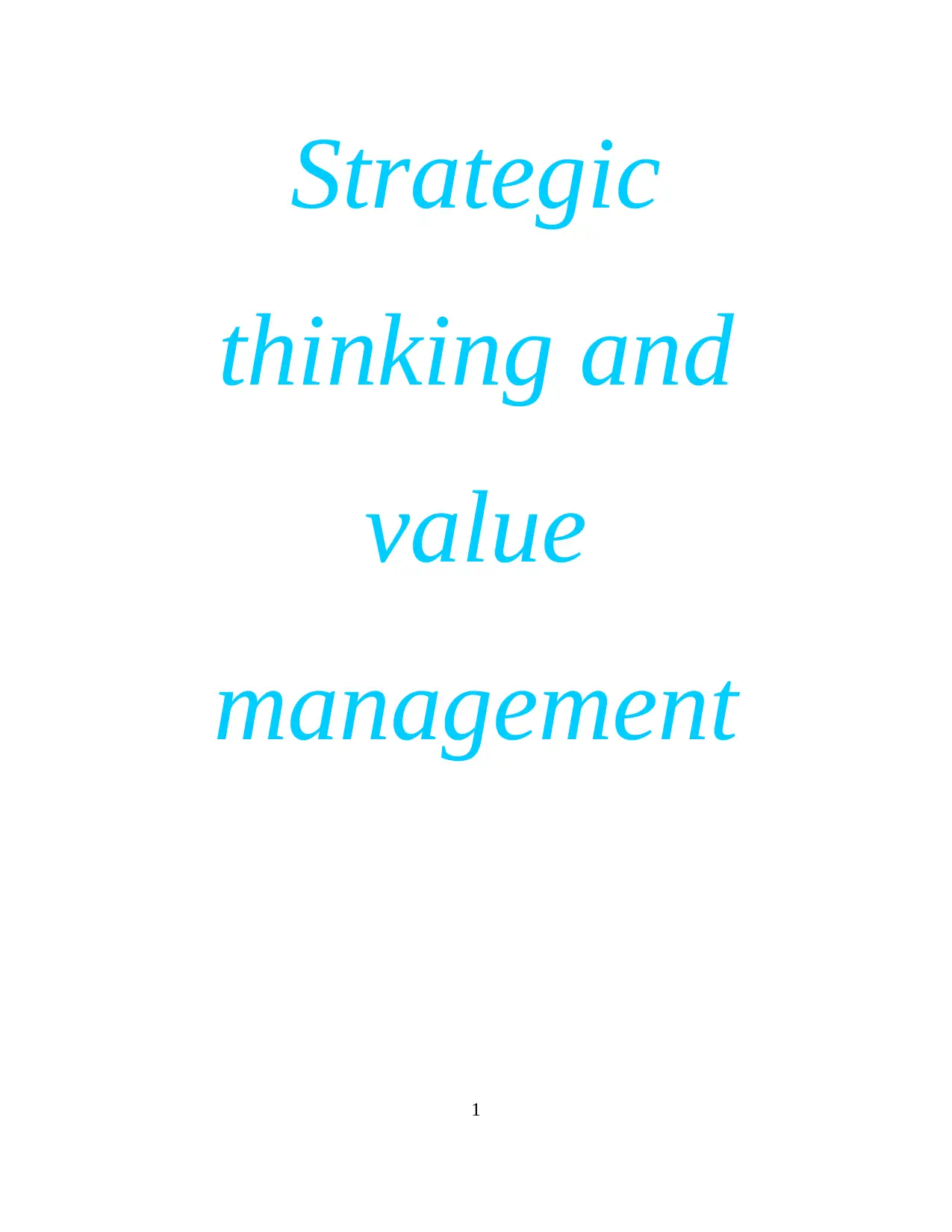
Strategic
thinking and
value
management
1
thinking and
value
management
1
Paraphrase This Document
Need a fresh take? Get an instant paraphrase of this document with our AI Paraphraser
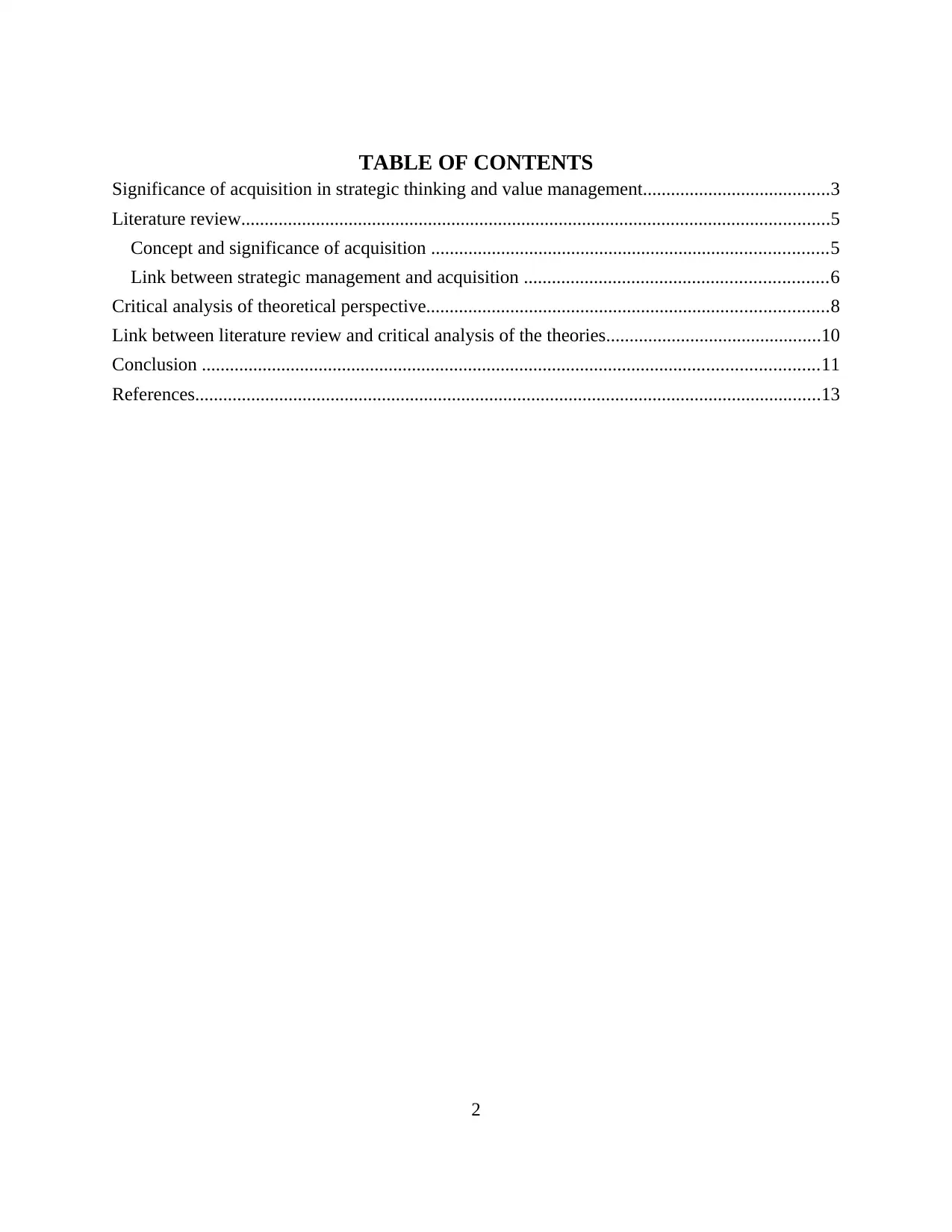
TABLE OF CONTENTS
Significance of acquisition in strategic thinking and value management........................................3
Literature review..............................................................................................................................5
Concept and significance of acquisition .....................................................................................5
Link between strategic management and acquisition .................................................................6
Critical analysis of theoretical perspective......................................................................................8
Link between literature review and critical analysis of the theories..............................................10
Conclusion ....................................................................................................................................11
References......................................................................................................................................13
2
Significance of acquisition in strategic thinking and value management........................................3
Literature review..............................................................................................................................5
Concept and significance of acquisition .....................................................................................5
Link between strategic management and acquisition .................................................................6
Critical analysis of theoretical perspective......................................................................................8
Link between literature review and critical analysis of the theories..............................................10
Conclusion ....................................................................................................................................11
References......................................................................................................................................13
2
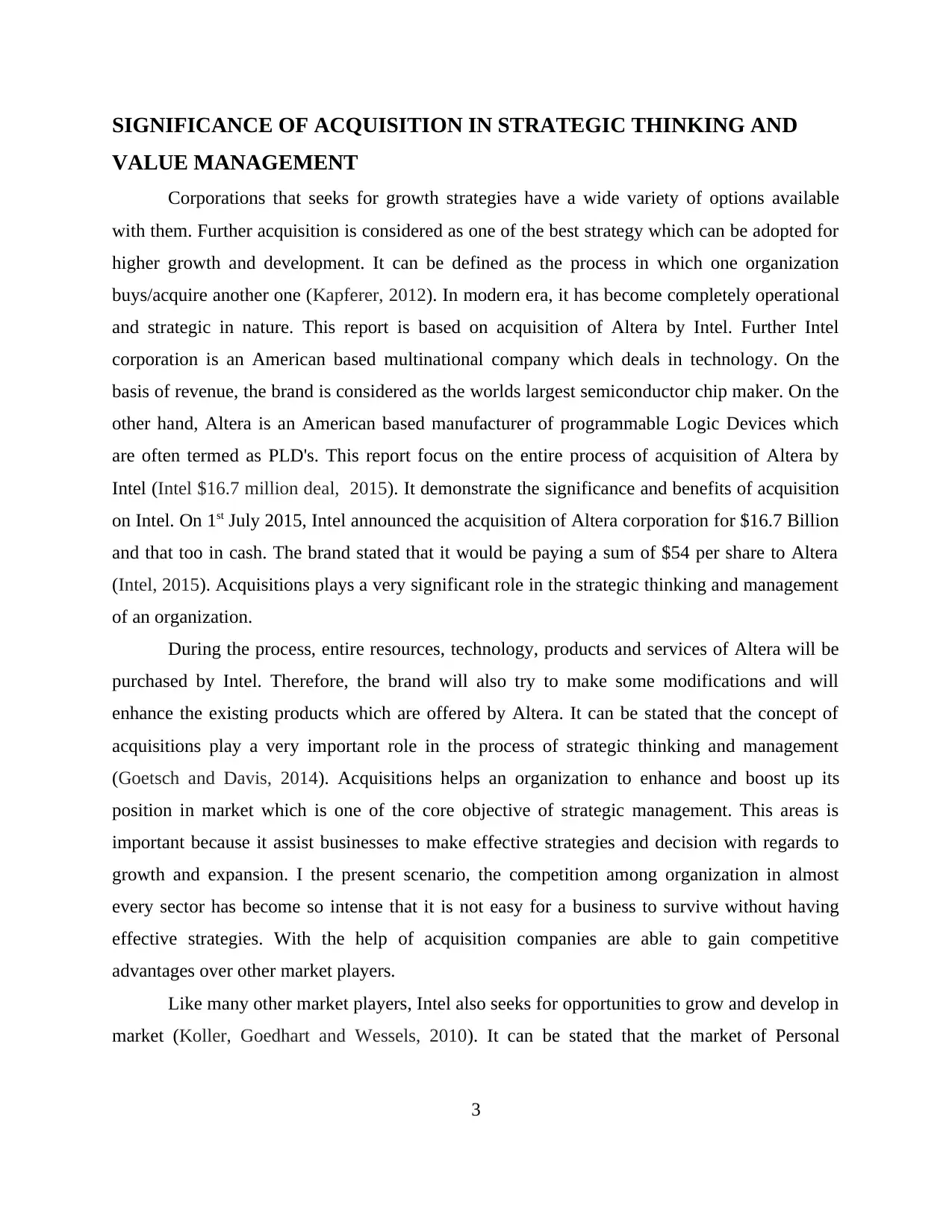
SIGNIFICANCE OF ACQUISITION IN STRATEGIC THINKING AND
VALUE MANAGEMENT
Corporations that seeks for growth strategies have a wide variety of options available
with them. Further acquisition is considered as one of the best strategy which can be adopted for
higher growth and development. It can be defined as the process in which one organization
buys/acquire another one (Kapferer, 2012). In modern era, it has become completely operational
and strategic in nature. This report is based on acquisition of Altera by Intel. Further Intel
corporation is an American based multinational company which deals in technology. On the
basis of revenue, the brand is considered as the worlds largest semiconductor chip maker. On the
other hand, Altera is an American based manufacturer of programmable Logic Devices which
are often termed as PLD's. This report focus on the entire process of acquisition of Altera by
Intel (Intel $16.7 million deal, 2015). It demonstrate the significance and benefits of acquisition
on Intel. On 1st July 2015, Intel announced the acquisition of Altera corporation for $16.7 Billion
and that too in cash. The brand stated that it would be paying a sum of $54 per share to Altera
(Intel, 2015). Acquisitions plays a very significant role in the strategic thinking and management
of an organization.
During the process, entire resources, technology, products and services of Altera will be
purchased by Intel. Therefore, the brand will also try to make some modifications and will
enhance the existing products which are offered by Altera. It can be stated that the concept of
acquisitions play a very important role in the process of strategic thinking and management
(Goetsch and Davis, 2014). Acquisitions helps an organization to enhance and boost up its
position in market which is one of the core objective of strategic management. This areas is
important because it assist businesses to make effective strategies and decision with regards to
growth and expansion. I the present scenario, the competition among organization in almost
every sector has become so intense that it is not easy for a business to survive without having
effective strategies. With the help of acquisition companies are able to gain competitive
advantages over other market players.
Like many other market players, Intel also seeks for opportunities to grow and develop in
market (Koller, Goedhart and Wessels, 2010). It can be stated that the market of Personal
3
VALUE MANAGEMENT
Corporations that seeks for growth strategies have a wide variety of options available
with them. Further acquisition is considered as one of the best strategy which can be adopted for
higher growth and development. It can be defined as the process in which one organization
buys/acquire another one (Kapferer, 2012). In modern era, it has become completely operational
and strategic in nature. This report is based on acquisition of Altera by Intel. Further Intel
corporation is an American based multinational company which deals in technology. On the
basis of revenue, the brand is considered as the worlds largest semiconductor chip maker. On the
other hand, Altera is an American based manufacturer of programmable Logic Devices which
are often termed as PLD's. This report focus on the entire process of acquisition of Altera by
Intel (Intel $16.7 million deal, 2015). It demonstrate the significance and benefits of acquisition
on Intel. On 1st July 2015, Intel announced the acquisition of Altera corporation for $16.7 Billion
and that too in cash. The brand stated that it would be paying a sum of $54 per share to Altera
(Intel, 2015). Acquisitions plays a very significant role in the strategic thinking and management
of an organization.
During the process, entire resources, technology, products and services of Altera will be
purchased by Intel. Therefore, the brand will also try to make some modifications and will
enhance the existing products which are offered by Altera. It can be stated that the concept of
acquisitions play a very important role in the process of strategic thinking and management
(Goetsch and Davis, 2014). Acquisitions helps an organization to enhance and boost up its
position in market which is one of the core objective of strategic management. This areas is
important because it assist businesses to make effective strategies and decision with regards to
growth and expansion. I the present scenario, the competition among organization in almost
every sector has become so intense that it is not easy for a business to survive without having
effective strategies. With the help of acquisition companies are able to gain competitive
advantages over other market players.
Like many other market players, Intel also seeks for opportunities to grow and develop in
market (Koller, Goedhart and Wessels, 2010). It can be stated that the market of Personal
3
⊘ This is a preview!⊘
Do you want full access?
Subscribe today to unlock all pages.

Trusted by 1+ million students worldwide
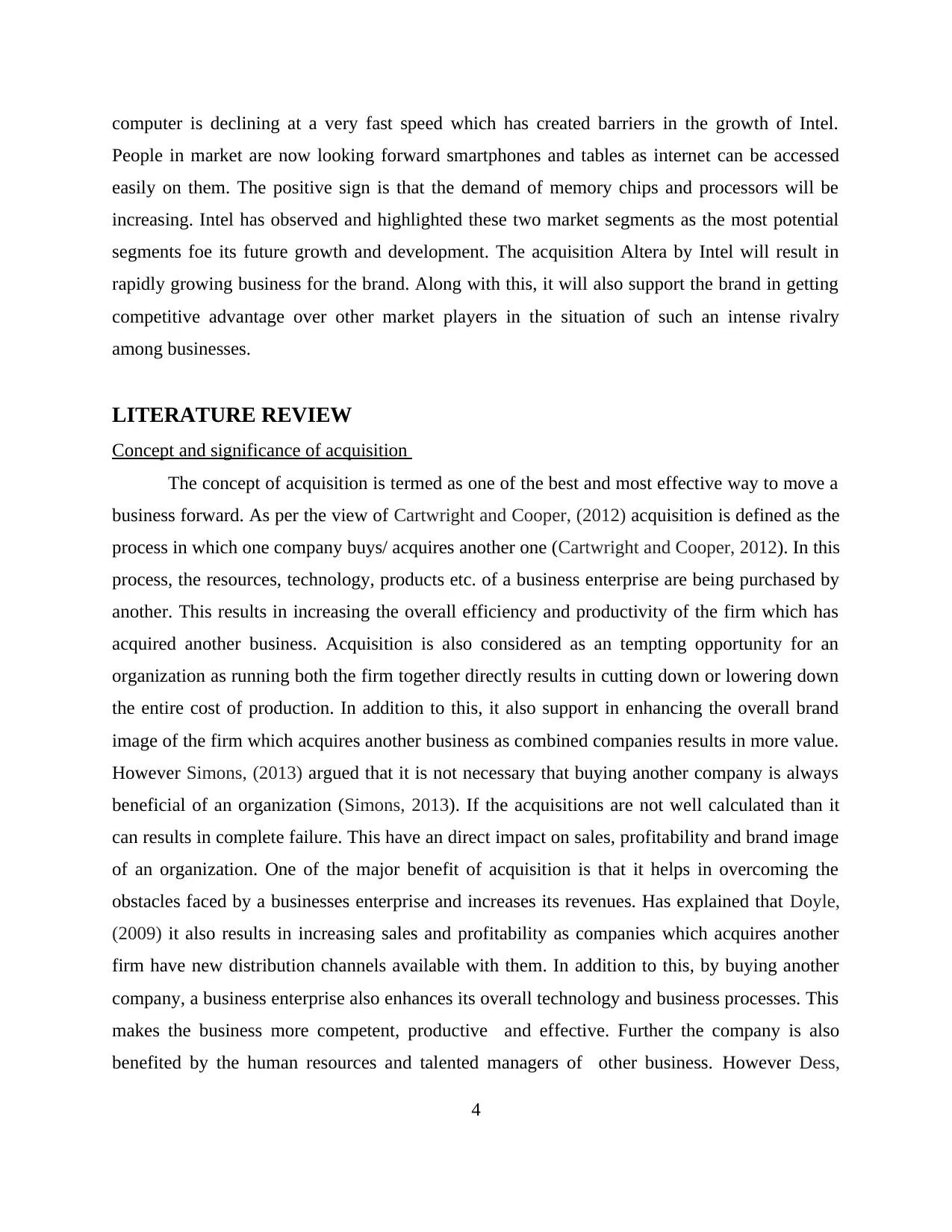
computer is declining at a very fast speed which has created barriers in the growth of Intel.
People in market are now looking forward smartphones and tables as internet can be accessed
easily on them. The positive sign is that the demand of memory chips and processors will be
increasing. Intel has observed and highlighted these two market segments as the most potential
segments foe its future growth and development. The acquisition Altera by Intel will result in
rapidly growing business for the brand. Along with this, it will also support the brand in getting
competitive advantage over other market players in the situation of such an intense rivalry
among businesses.
LITERATURE REVIEW
Concept and significance of acquisition
The concept of acquisition is termed as one of the best and most effective way to move a
business forward. As per the view of Cartwright and Cooper, (2012) acquisition is defined as the
process in which one company buys/ acquires another one (Cartwright and Cooper, 2012). In this
process, the resources, technology, products etc. of a business enterprise are being purchased by
another. This results in increasing the overall efficiency and productivity of the firm which has
acquired another business. Acquisition is also considered as an tempting opportunity for an
organization as running both the firm together directly results in cutting down or lowering down
the entire cost of production. In addition to this, it also support in enhancing the overall brand
image of the firm which acquires another business as combined companies results in more value.
However Simons, (2013) argued that it is not necessary that buying another company is always
beneficial of an organization (Simons, 2013). If the acquisitions are not well calculated than it
can results in complete failure. This have an direct impact on sales, profitability and brand image
of an organization. One of the major benefit of acquisition is that it helps in overcoming the
obstacles faced by a businesses enterprise and increases its revenues. Has explained that Doyle,
(2009) it also results in increasing sales and profitability as companies which acquires another
firm have new distribution channels available with them. In addition to this, by buying another
company, a business enterprise also enhances its overall technology and business processes. This
makes the business more competent, productive and effective. Further the company is also
benefited by the human resources and talented managers of other business. However Dess,
4
People in market are now looking forward smartphones and tables as internet can be accessed
easily on them. The positive sign is that the demand of memory chips and processors will be
increasing. Intel has observed and highlighted these two market segments as the most potential
segments foe its future growth and development. The acquisition Altera by Intel will result in
rapidly growing business for the brand. Along with this, it will also support the brand in getting
competitive advantage over other market players in the situation of such an intense rivalry
among businesses.
LITERATURE REVIEW
Concept and significance of acquisition
The concept of acquisition is termed as one of the best and most effective way to move a
business forward. As per the view of Cartwright and Cooper, (2012) acquisition is defined as the
process in which one company buys/ acquires another one (Cartwright and Cooper, 2012). In this
process, the resources, technology, products etc. of a business enterprise are being purchased by
another. This results in increasing the overall efficiency and productivity of the firm which has
acquired another business. Acquisition is also considered as an tempting opportunity for an
organization as running both the firm together directly results in cutting down or lowering down
the entire cost of production. In addition to this, it also support in enhancing the overall brand
image of the firm which acquires another business as combined companies results in more value.
However Simons, (2013) argued that it is not necessary that buying another company is always
beneficial of an organization (Simons, 2013). If the acquisitions are not well calculated than it
can results in complete failure. This have an direct impact on sales, profitability and brand image
of an organization. One of the major benefit of acquisition is that it helps in overcoming the
obstacles faced by a businesses enterprise and increases its revenues. Has explained that Doyle,
(2009) it also results in increasing sales and profitability as companies which acquires another
firm have new distribution channels available with them. In addition to this, by buying another
company, a business enterprise also enhances its overall technology and business processes. This
makes the business more competent, productive and effective. Further the company is also
benefited by the human resources and talented managers of other business. However Dess,
4
Paraphrase This Document
Need a fresh take? Get an instant paraphrase of this document with our AI Paraphraser
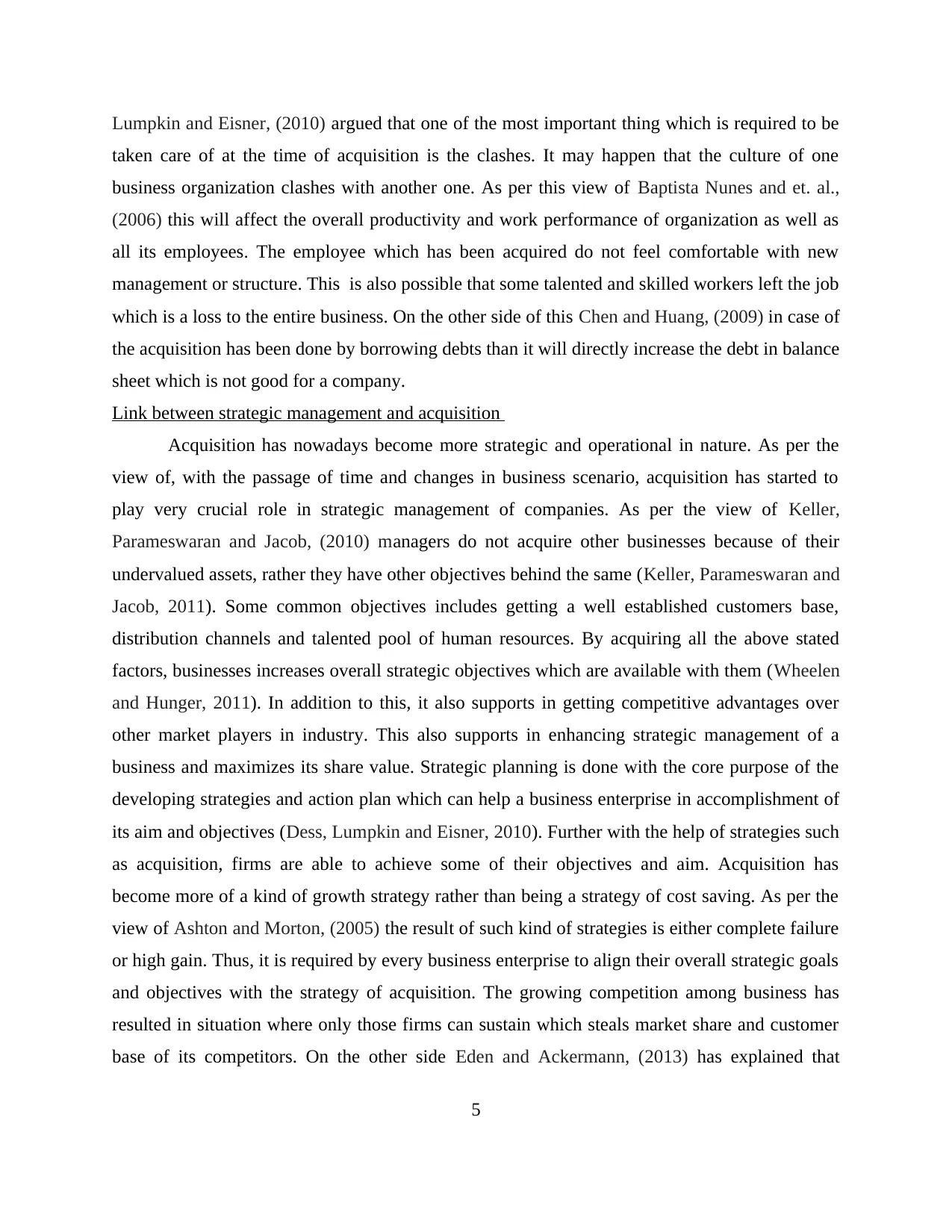
Lumpkin and Eisner, (2010) argued that one of the most important thing which is required to be
taken care of at the time of acquisition is the clashes. It may happen that the culture of one
business organization clashes with another one. As per this view of Baptista Nunes and et. al.,
(2006) this will affect the overall productivity and work performance of organization as well as
all its employees. The employee which has been acquired do not feel comfortable with new
management or structure. This is also possible that some talented and skilled workers left the job
which is a loss to the entire business. On the other side of this Chen and Huang, (2009) in case of
the acquisition has been done by borrowing debts than it will directly increase the debt in balance
sheet which is not good for a company.
Link between strategic management and acquisition
Acquisition has nowadays become more strategic and operational in nature. As per the
view of, with the passage of time and changes in business scenario, acquisition has started to
play very crucial role in strategic management of companies. As per the view of Keller,
Parameswaran and Jacob, (2010) managers do not acquire other businesses because of their
undervalued assets, rather they have other objectives behind the same (Keller, Parameswaran and
Jacob, 2011). Some common objectives includes getting a well established customers base,
distribution channels and talented pool of human resources. By acquiring all the above stated
factors, businesses increases overall strategic objectives which are available with them (Wheelen
and Hunger, 2011). In addition to this, it also supports in getting competitive advantages over
other market players in industry. This also supports in enhancing strategic management of a
business and maximizes its share value. Strategic planning is done with the core purpose of the
developing strategies and action plan which can help a business enterprise in accomplishment of
its aim and objectives (Dess, Lumpkin and Eisner, 2010). Further with the help of strategies such
as acquisition, firms are able to achieve some of their objectives and aim. Acquisition has
become more of a kind of growth strategy rather than being a strategy of cost saving. As per the
view of Ashton and Morton, (2005) the result of such kind of strategies is either complete failure
or high gain. Thus, it is required by every business enterprise to align their overall strategic goals
and objectives with the strategy of acquisition. The growing competition among business has
resulted in situation where only those firms can sustain which steals market share and customer
base of its competitors. On the other side Eden and Ackermann, (2013) has explained that
5
taken care of at the time of acquisition is the clashes. It may happen that the culture of one
business organization clashes with another one. As per this view of Baptista Nunes and et. al.,
(2006) this will affect the overall productivity and work performance of organization as well as
all its employees. The employee which has been acquired do not feel comfortable with new
management or structure. This is also possible that some talented and skilled workers left the job
which is a loss to the entire business. On the other side of this Chen and Huang, (2009) in case of
the acquisition has been done by borrowing debts than it will directly increase the debt in balance
sheet which is not good for a company.
Link between strategic management and acquisition
Acquisition has nowadays become more strategic and operational in nature. As per the
view of, with the passage of time and changes in business scenario, acquisition has started to
play very crucial role in strategic management of companies. As per the view of Keller,
Parameswaran and Jacob, (2010) managers do not acquire other businesses because of their
undervalued assets, rather they have other objectives behind the same (Keller, Parameswaran and
Jacob, 2011). Some common objectives includes getting a well established customers base,
distribution channels and talented pool of human resources. By acquiring all the above stated
factors, businesses increases overall strategic objectives which are available with them (Wheelen
and Hunger, 2011). In addition to this, it also supports in getting competitive advantages over
other market players in industry. This also supports in enhancing strategic management of a
business and maximizes its share value. Strategic planning is done with the core purpose of the
developing strategies and action plan which can help a business enterprise in accomplishment of
its aim and objectives (Dess, Lumpkin and Eisner, 2010). Further with the help of strategies such
as acquisition, firms are able to achieve some of their objectives and aim. Acquisition has
become more of a kind of growth strategy rather than being a strategy of cost saving. As per the
view of Ashton and Morton, (2005) the result of such kind of strategies is either complete failure
or high gain. Thus, it is required by every business enterprise to align their overall strategic goals
and objectives with the strategy of acquisition. The growing competition among business has
resulted in situation where only those firms can sustain which steals market share and customer
base of its competitors. On the other side Eden and Ackermann, (2013) has explained that
5
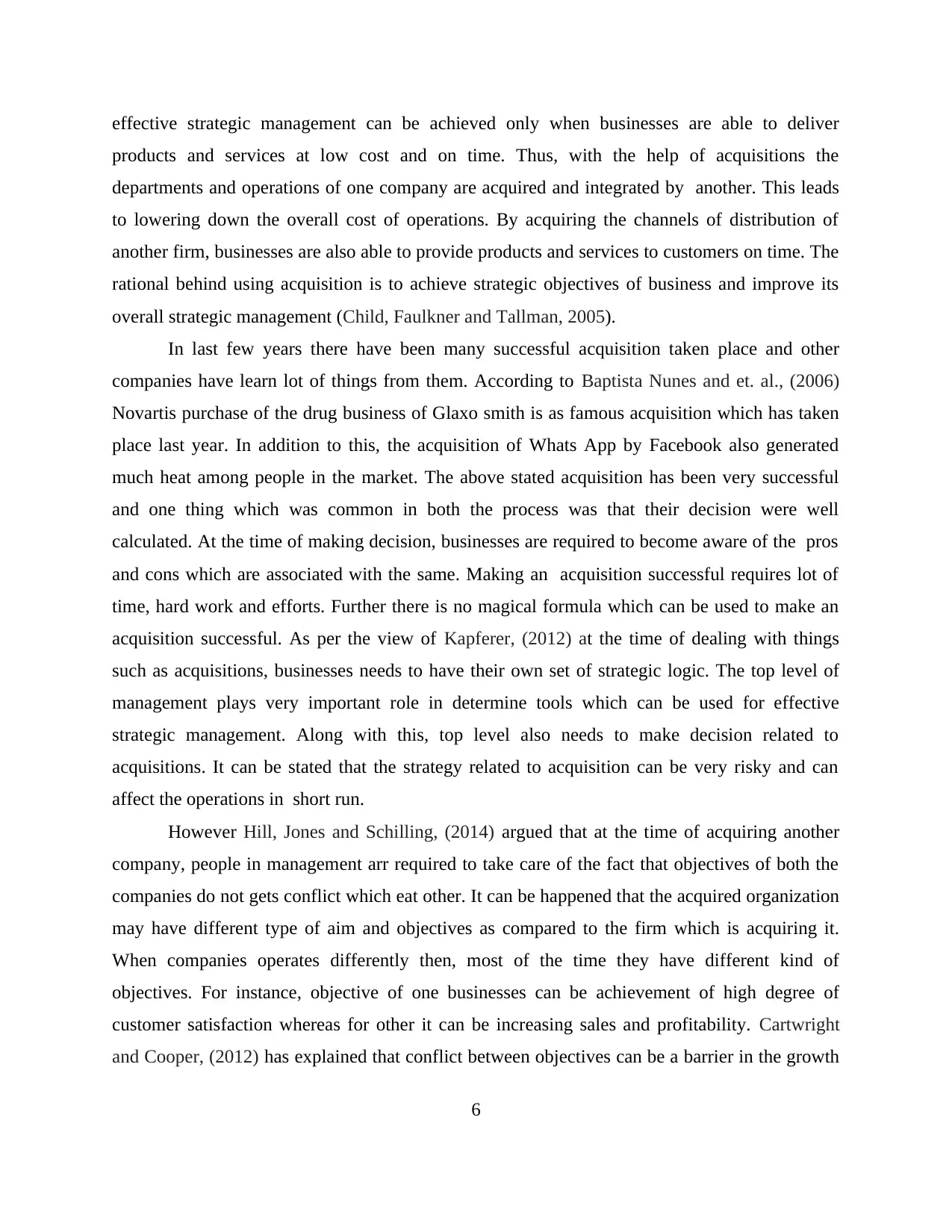
effective strategic management can be achieved only when businesses are able to deliver
products and services at low cost and on time. Thus, with the help of acquisitions the
departments and operations of one company are acquired and integrated by another. This leads
to lowering down the overall cost of operations. By acquiring the channels of distribution of
another firm, businesses are also able to provide products and services to customers on time. The
rational behind using acquisition is to achieve strategic objectives of business and improve its
overall strategic management (Child, Faulkner and Tallman, 2005).
In last few years there have been many successful acquisition taken place and other
companies have learn lot of things from them. According to Baptista Nunes and et. al., (2006)
Novartis purchase of the drug business of Glaxo smith is as famous acquisition which has taken
place last year. In addition to this, the acquisition of Whats App by Facebook also generated
much heat among people in the market. The above stated acquisition has been very successful
and one thing which was common in both the process was that their decision were well
calculated. At the time of making decision, businesses are required to become aware of the pros
and cons which are associated with the same. Making an acquisition successful requires lot of
time, hard work and efforts. Further there is no magical formula which can be used to make an
acquisition successful. As per the view of Kapferer, (2012) at the time of dealing with things
such as acquisitions, businesses needs to have their own set of strategic logic. The top level of
management plays very important role in determine tools which can be used for effective
strategic management. Along with this, top level also needs to make decision related to
acquisitions. It can be stated that the strategy related to acquisition can be very risky and can
affect the operations in short run.
However Hill, Jones and Schilling, (2014) argued that at the time of acquiring another
company, people in management arr required to take care of the fact that objectives of both the
companies do not gets conflict which eat other. It can be happened that the acquired organization
may have different type of aim and objectives as compared to the firm which is acquiring it.
When companies operates differently then, most of the time they have different kind of
objectives. For instance, objective of one businesses can be achievement of high degree of
customer satisfaction whereas for other it can be increasing sales and profitability. Cartwright
and Cooper, (2012) has explained that conflict between objectives can be a barrier in the growth
6
products and services at low cost and on time. Thus, with the help of acquisitions the
departments and operations of one company are acquired and integrated by another. This leads
to lowering down the overall cost of operations. By acquiring the channels of distribution of
another firm, businesses are also able to provide products and services to customers on time. The
rational behind using acquisition is to achieve strategic objectives of business and improve its
overall strategic management (Child, Faulkner and Tallman, 2005).
In last few years there have been many successful acquisition taken place and other
companies have learn lot of things from them. According to Baptista Nunes and et. al., (2006)
Novartis purchase of the drug business of Glaxo smith is as famous acquisition which has taken
place last year. In addition to this, the acquisition of Whats App by Facebook also generated
much heat among people in the market. The above stated acquisition has been very successful
and one thing which was common in both the process was that their decision were well
calculated. At the time of making decision, businesses are required to become aware of the pros
and cons which are associated with the same. Making an acquisition successful requires lot of
time, hard work and efforts. Further there is no magical formula which can be used to make an
acquisition successful. As per the view of Kapferer, (2012) at the time of dealing with things
such as acquisitions, businesses needs to have their own set of strategic logic. The top level of
management plays very important role in determine tools which can be used for effective
strategic management. Along with this, top level also needs to make decision related to
acquisitions. It can be stated that the strategy related to acquisition can be very risky and can
affect the operations in short run.
However Hill, Jones and Schilling, (2014) argued that at the time of acquiring another
company, people in management arr required to take care of the fact that objectives of both the
companies do not gets conflict which eat other. It can be happened that the acquired organization
may have different type of aim and objectives as compared to the firm which is acquiring it.
When companies operates differently then, most of the time they have different kind of
objectives. For instance, objective of one businesses can be achievement of high degree of
customer satisfaction whereas for other it can be increasing sales and profitability. Cartwright
and Cooper, (2012) has explained that conflict between objectives can be a barrier in the growth
6
⊘ This is a preview!⊘
Do you want full access?
Subscribe today to unlock all pages.

Trusted by 1+ million students worldwide
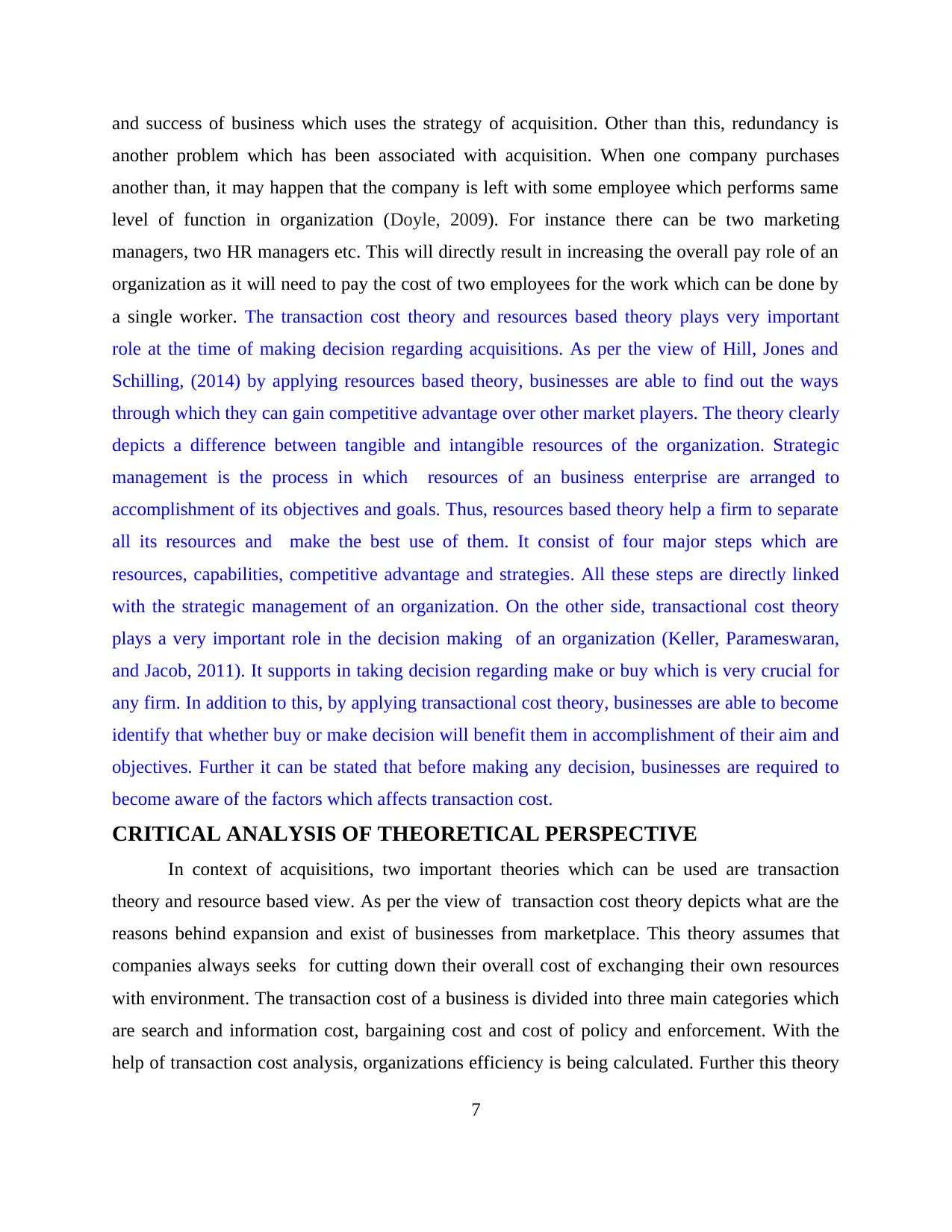
and success of business which uses the strategy of acquisition. Other than this, redundancy is
another problem which has been associated with acquisition. When one company purchases
another than, it may happen that the company is left with some employee which performs same
level of function in organization (Doyle, 2009). For instance there can be two marketing
managers, two HR managers etc. This will directly result in increasing the overall pay role of an
organization as it will need to pay the cost of two employees for the work which can be done by
a single worker. The transaction cost theory and resources based theory plays very important
role at the time of making decision regarding acquisitions. As per the view of Hill, Jones and
Schilling, (2014) by applying resources based theory, businesses are able to find out the ways
through which they can gain competitive advantage over other market players. The theory clearly
depicts a difference between tangible and intangible resources of the organization. Strategic
management is the process in which resources of an business enterprise are arranged to
accomplishment of its objectives and goals. Thus, resources based theory help a firm to separate
all its resources and make the best use of them. It consist of four major steps which are
resources, capabilities, competitive advantage and strategies. All these steps are directly linked
with the strategic management of an organization. On the other side, transactional cost theory
plays a very important role in the decision making of an organization (Keller, Parameswaran,
and Jacob, 2011). It supports in taking decision regarding make or buy which is very crucial for
any firm. In addition to this, by applying transactional cost theory, businesses are able to become
identify that whether buy or make decision will benefit them in accomplishment of their aim and
objectives. Further it can be stated that before making any decision, businesses are required to
become aware of the factors which affects transaction cost.
CRITICAL ANALYSIS OF THEORETICAL PERSPECTIVE
In context of acquisitions, two important theories which can be used are transaction
theory and resource based view. As per the view of transaction cost theory depicts what are the
reasons behind expansion and exist of businesses from marketplace. This theory assumes that
companies always seeks for cutting down their overall cost of exchanging their own resources
with environment. The transaction cost of a business is divided into three main categories which
are search and information cost, bargaining cost and cost of policy and enforcement. With the
help of transaction cost analysis, organizations efficiency is being calculated. Further this theory
7
another problem which has been associated with acquisition. When one company purchases
another than, it may happen that the company is left with some employee which performs same
level of function in organization (Doyle, 2009). For instance there can be two marketing
managers, two HR managers etc. This will directly result in increasing the overall pay role of an
organization as it will need to pay the cost of two employees for the work which can be done by
a single worker. The transaction cost theory and resources based theory plays very important
role at the time of making decision regarding acquisitions. As per the view of Hill, Jones and
Schilling, (2014) by applying resources based theory, businesses are able to find out the ways
through which they can gain competitive advantage over other market players. The theory clearly
depicts a difference between tangible and intangible resources of the organization. Strategic
management is the process in which resources of an business enterprise are arranged to
accomplishment of its objectives and goals. Thus, resources based theory help a firm to separate
all its resources and make the best use of them. It consist of four major steps which are
resources, capabilities, competitive advantage and strategies. All these steps are directly linked
with the strategic management of an organization. On the other side, transactional cost theory
plays a very important role in the decision making of an organization (Keller, Parameswaran,
and Jacob, 2011). It supports in taking decision regarding make or buy which is very crucial for
any firm. In addition to this, by applying transactional cost theory, businesses are able to become
identify that whether buy or make decision will benefit them in accomplishment of their aim and
objectives. Further it can be stated that before making any decision, businesses are required to
become aware of the factors which affects transaction cost.
CRITICAL ANALYSIS OF THEORETICAL PERSPECTIVE
In context of acquisitions, two important theories which can be used are transaction
theory and resource based view. As per the view of transaction cost theory depicts what are the
reasons behind expansion and exist of businesses from marketplace. This theory assumes that
companies always seeks for cutting down their overall cost of exchanging their own resources
with environment. The transaction cost of a business is divided into three main categories which
are search and information cost, bargaining cost and cost of policy and enforcement. With the
help of transaction cost analysis, organizations efficiency is being calculated. Further this theory
7
Paraphrase This Document
Need a fresh take? Get an instant paraphrase of this document with our AI Paraphraser
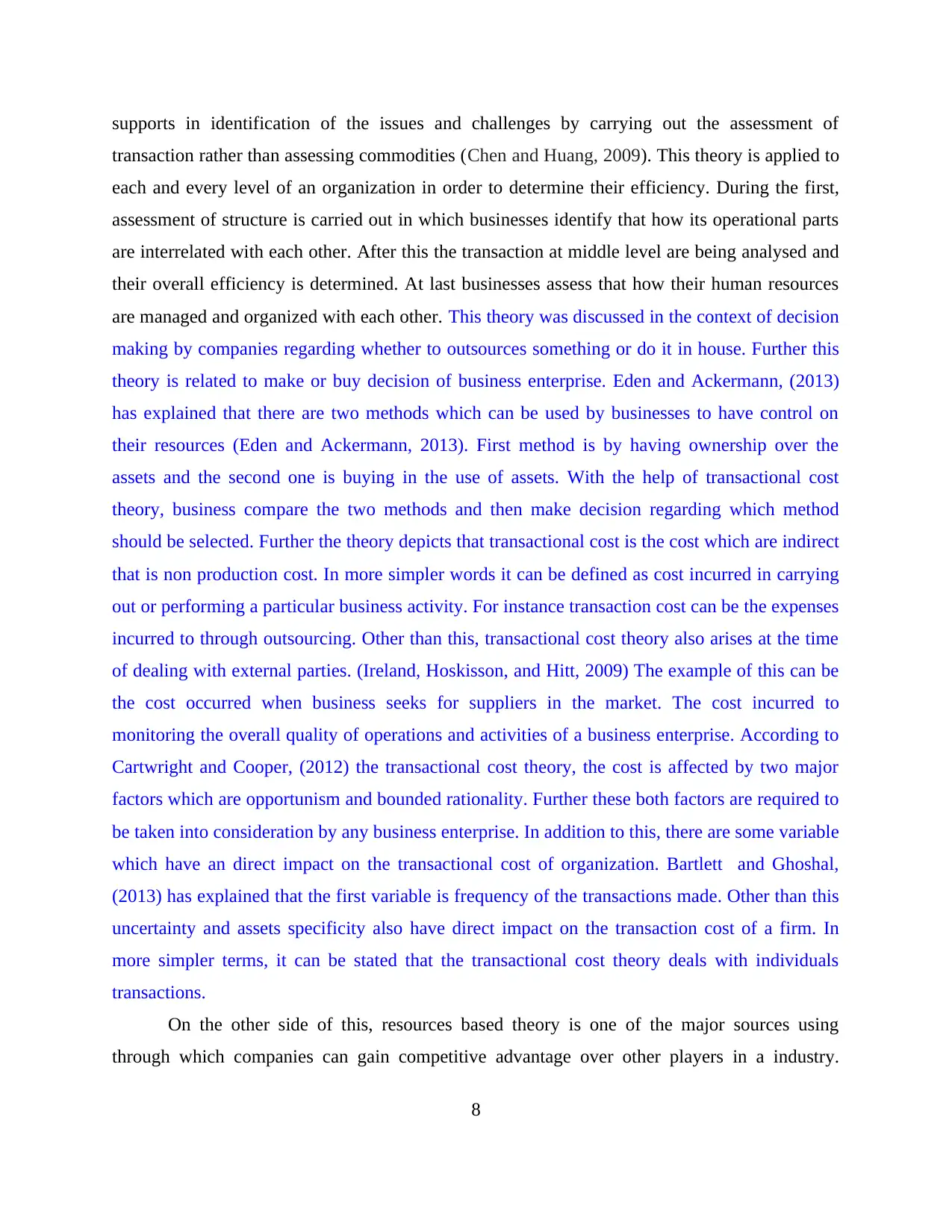
supports in identification of the issues and challenges by carrying out the assessment of
transaction rather than assessing commodities (Chen and Huang, 2009). This theory is applied to
each and every level of an organization in order to determine their efficiency. During the first,
assessment of structure is carried out in which businesses identify that how its operational parts
are interrelated with each other. After this the transaction at middle level are being analysed and
their overall efficiency is determined. At last businesses assess that how their human resources
are managed and organized with each other. This theory was discussed in the context of decision
making by companies regarding whether to outsources something or do it in house. Further this
theory is related to make or buy decision of business enterprise. Eden and Ackermann, (2013)
has explained that there are two methods which can be used by businesses to have control on
their resources (Eden and Ackermann, 2013). First method is by having ownership over the
assets and the second one is buying in the use of assets. With the help of transactional cost
theory, business compare the two methods and then make decision regarding which method
should be selected. Further the theory depicts that transactional cost is the cost which are indirect
that is non production cost. In more simpler words it can be defined as cost incurred in carrying
out or performing a particular business activity. For instance transaction cost can be the expenses
incurred to through outsourcing. Other than this, transactional cost theory also arises at the time
of dealing with external parties. (Ireland, Hoskisson, and Hitt, 2009) The example of this can be
the cost occurred when business seeks for suppliers in the market. The cost incurred to
monitoring the overall quality of operations and activities of a business enterprise. According to
Cartwright and Cooper, (2012) the transactional cost theory, the cost is affected by two major
factors which are opportunism and bounded rationality. Further these both factors are required to
be taken into consideration by any business enterprise. In addition to this, there are some variable
which have an direct impact on the transactional cost of organization. Bartlett and Ghoshal,
(2013) has explained that the first variable is frequency of the transactions made. Other than this
uncertainty and assets specificity also have direct impact on the transaction cost of a firm. In
more simpler terms, it can be stated that the transactional cost theory deals with individuals
transactions.
On the other side of this, resources based theory is one of the major sources using
through which companies can gain competitive advantage over other players in a industry.
8
transaction rather than assessing commodities (Chen and Huang, 2009). This theory is applied to
each and every level of an organization in order to determine their efficiency. During the first,
assessment of structure is carried out in which businesses identify that how its operational parts
are interrelated with each other. After this the transaction at middle level are being analysed and
their overall efficiency is determined. At last businesses assess that how their human resources
are managed and organized with each other. This theory was discussed in the context of decision
making by companies regarding whether to outsources something or do it in house. Further this
theory is related to make or buy decision of business enterprise. Eden and Ackermann, (2013)
has explained that there are two methods which can be used by businesses to have control on
their resources (Eden and Ackermann, 2013). First method is by having ownership over the
assets and the second one is buying in the use of assets. With the help of transactional cost
theory, business compare the two methods and then make decision regarding which method
should be selected. Further the theory depicts that transactional cost is the cost which are indirect
that is non production cost. In more simpler words it can be defined as cost incurred in carrying
out or performing a particular business activity. For instance transaction cost can be the expenses
incurred to through outsourcing. Other than this, transactional cost theory also arises at the time
of dealing with external parties. (Ireland, Hoskisson, and Hitt, 2009) The example of this can be
the cost occurred when business seeks for suppliers in the market. The cost incurred to
monitoring the overall quality of operations and activities of a business enterprise. According to
Cartwright and Cooper, (2012) the transactional cost theory, the cost is affected by two major
factors which are opportunism and bounded rationality. Further these both factors are required to
be taken into consideration by any business enterprise. In addition to this, there are some variable
which have an direct impact on the transactional cost of organization. Bartlett and Ghoshal,
(2013) has explained that the first variable is frequency of the transactions made. Other than this
uncertainty and assets specificity also have direct impact on the transaction cost of a firm. In
more simpler terms, it can be stated that the transactional cost theory deals with individuals
transactions.
On the other side of this, resources based theory is one of the major sources using
through which companies can gain competitive advantage over other players in a industry.
8
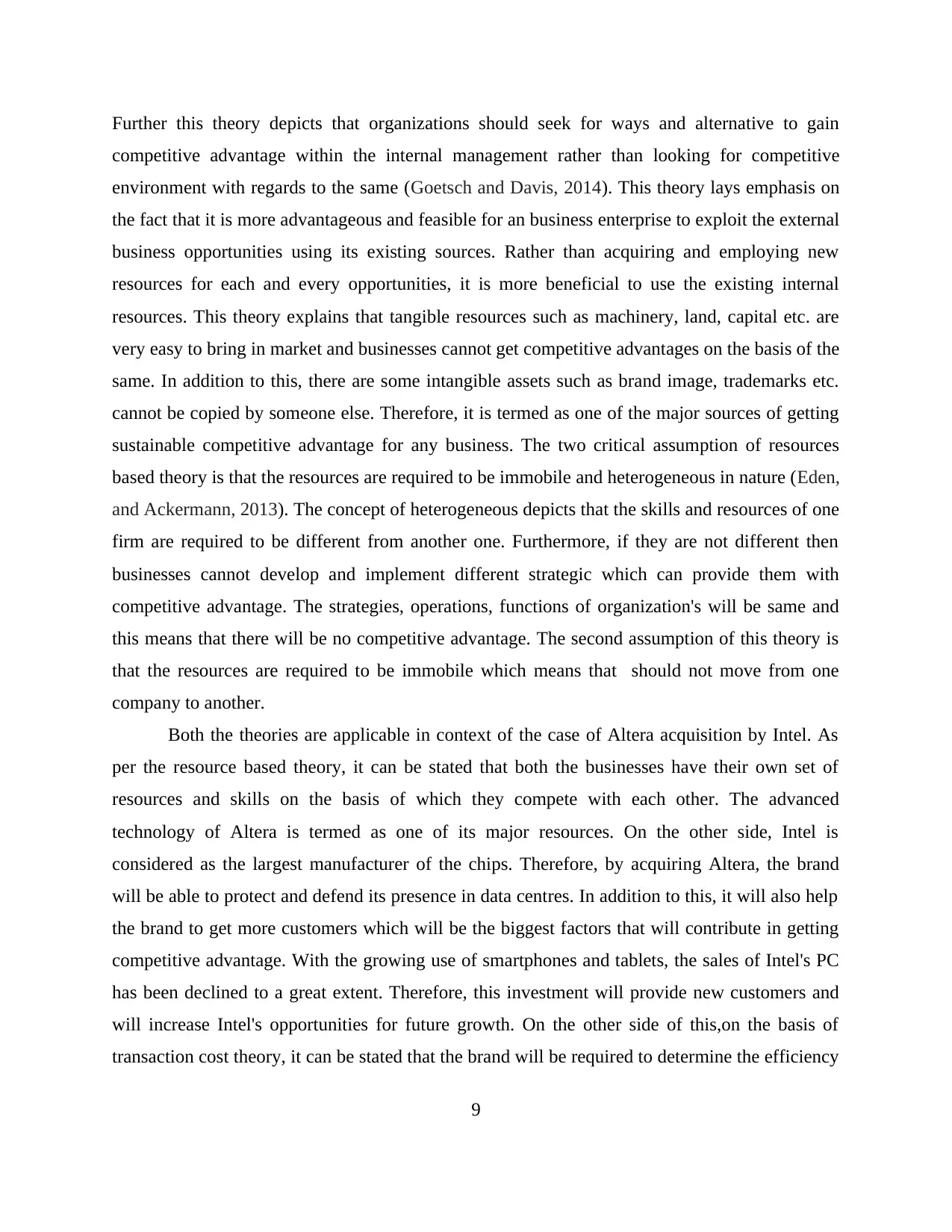
Further this theory depicts that organizations should seek for ways and alternative to gain
competitive advantage within the internal management rather than looking for competitive
environment with regards to the same (Goetsch and Davis, 2014). This theory lays emphasis on
the fact that it is more advantageous and feasible for an business enterprise to exploit the external
business opportunities using its existing sources. Rather than acquiring and employing new
resources for each and every opportunities, it is more beneficial to use the existing internal
resources. This theory explains that tangible resources such as machinery, land, capital etc. are
very easy to bring in market and businesses cannot get competitive advantages on the basis of the
same. In addition to this, there are some intangible assets such as brand image, trademarks etc.
cannot be copied by someone else. Therefore, it is termed as one of the major sources of getting
sustainable competitive advantage for any business. The two critical assumption of resources
based theory is that the resources are required to be immobile and heterogeneous in nature (Eden,
and Ackermann, 2013). The concept of heterogeneous depicts that the skills and resources of one
firm are required to be different from another one. Furthermore, if they are not different then
businesses cannot develop and implement different strategic which can provide them with
competitive advantage. The strategies, operations, functions of organization's will be same and
this means that there will be no competitive advantage. The second assumption of this theory is
that the resources are required to be immobile which means that should not move from one
company to another.
Both the theories are applicable in context of the case of Altera acquisition by Intel. As
per the resource based theory, it can be stated that both the businesses have their own set of
resources and skills on the basis of which they compete with each other. The advanced
technology of Altera is termed as one of its major resources. On the other side, Intel is
considered as the largest manufacturer of the chips. Therefore, by acquiring Altera, the brand
will be able to protect and defend its presence in data centres. In addition to this, it will also help
the brand to get more customers which will be the biggest factors that will contribute in getting
competitive advantage. With the growing use of smartphones and tablets, the sales of Intel's PC
has been declined to a great extent. Therefore, this investment will provide new customers and
will increase Intel's opportunities for future growth. On the other side of this,on the basis of
transaction cost theory, it can be stated that the brand will be required to determine the efficiency
9
competitive advantage within the internal management rather than looking for competitive
environment with regards to the same (Goetsch and Davis, 2014). This theory lays emphasis on
the fact that it is more advantageous and feasible for an business enterprise to exploit the external
business opportunities using its existing sources. Rather than acquiring and employing new
resources for each and every opportunities, it is more beneficial to use the existing internal
resources. This theory explains that tangible resources such as machinery, land, capital etc. are
very easy to bring in market and businesses cannot get competitive advantages on the basis of the
same. In addition to this, there are some intangible assets such as brand image, trademarks etc.
cannot be copied by someone else. Therefore, it is termed as one of the major sources of getting
sustainable competitive advantage for any business. The two critical assumption of resources
based theory is that the resources are required to be immobile and heterogeneous in nature (Eden,
and Ackermann, 2013). The concept of heterogeneous depicts that the skills and resources of one
firm are required to be different from another one. Furthermore, if they are not different then
businesses cannot develop and implement different strategic which can provide them with
competitive advantage. The strategies, operations, functions of organization's will be same and
this means that there will be no competitive advantage. The second assumption of this theory is
that the resources are required to be immobile which means that should not move from one
company to another.
Both the theories are applicable in context of the case of Altera acquisition by Intel. As
per the resource based theory, it can be stated that both the businesses have their own set of
resources and skills on the basis of which they compete with each other. The advanced
technology of Altera is termed as one of its major resources. On the other side, Intel is
considered as the largest manufacturer of the chips. Therefore, by acquiring Altera, the brand
will be able to protect and defend its presence in data centres. In addition to this, it will also help
the brand to get more customers which will be the biggest factors that will contribute in getting
competitive advantage. With the growing use of smartphones and tablets, the sales of Intel's PC
has been declined to a great extent. Therefore, this investment will provide new customers and
will increase Intel's opportunities for future growth. On the other side of this,on the basis of
transaction cost theory, it can be stated that the brand will be required to determine the efficiency
9
⊘ This is a preview!⊘
Do you want full access?
Subscribe today to unlock all pages.

Trusted by 1+ million students worldwide
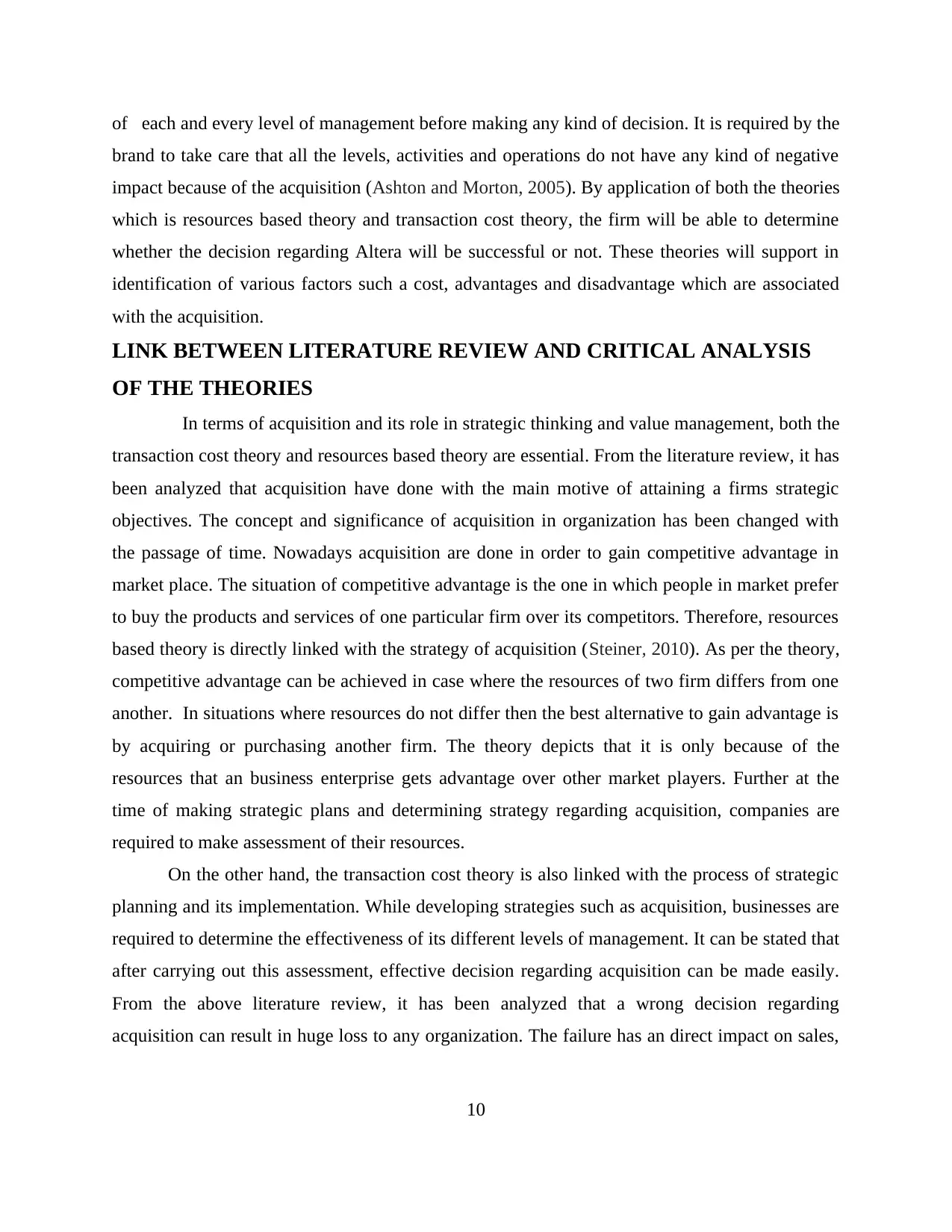
of each and every level of management before making any kind of decision. It is required by the
brand to take care that all the levels, activities and operations do not have any kind of negative
impact because of the acquisition (Ashton and Morton, 2005). By application of both the theories
which is resources based theory and transaction cost theory, the firm will be able to determine
whether the decision regarding Altera will be successful or not. These theories will support in
identification of various factors such a cost, advantages and disadvantage which are associated
with the acquisition.
LINK BETWEEN LITERATURE REVIEW AND CRITICAL ANALYSIS
OF THE THEORIES
In terms of acquisition and its role in strategic thinking and value management, both the
transaction cost theory and resources based theory are essential. From the literature review, it has
been analyzed that acquisition have done with the main motive of attaining a firms strategic
objectives. The concept and significance of acquisition in organization has been changed with
the passage of time. Nowadays acquisition are done in order to gain competitive advantage in
market place. The situation of competitive advantage is the one in which people in market prefer
to buy the products and services of one particular firm over its competitors. Therefore, resources
based theory is directly linked with the strategy of acquisition (Steiner, 2010). As per the theory,
competitive advantage can be achieved in case where the resources of two firm differs from one
another. In situations where resources do not differ then the best alternative to gain advantage is
by acquiring or purchasing another firm. The theory depicts that it is only because of the
resources that an business enterprise gets advantage over other market players. Further at the
time of making strategic plans and determining strategy regarding acquisition, companies are
required to make assessment of their resources.
On the other hand, the transaction cost theory is also linked with the process of strategic
planning and its implementation. While developing strategies such as acquisition, businesses are
required to determine the effectiveness of its different levels of management. It can be stated that
after carrying out this assessment, effective decision regarding acquisition can be made easily.
From the above literature review, it has been analyzed that a wrong decision regarding
acquisition can result in huge loss to any organization. The failure has an direct impact on sales,
10
brand to take care that all the levels, activities and operations do not have any kind of negative
impact because of the acquisition (Ashton and Morton, 2005). By application of both the theories
which is resources based theory and transaction cost theory, the firm will be able to determine
whether the decision regarding Altera will be successful or not. These theories will support in
identification of various factors such a cost, advantages and disadvantage which are associated
with the acquisition.
LINK BETWEEN LITERATURE REVIEW AND CRITICAL ANALYSIS
OF THE THEORIES
In terms of acquisition and its role in strategic thinking and value management, both the
transaction cost theory and resources based theory are essential. From the literature review, it has
been analyzed that acquisition have done with the main motive of attaining a firms strategic
objectives. The concept and significance of acquisition in organization has been changed with
the passage of time. Nowadays acquisition are done in order to gain competitive advantage in
market place. The situation of competitive advantage is the one in which people in market prefer
to buy the products and services of one particular firm over its competitors. Therefore, resources
based theory is directly linked with the strategy of acquisition (Steiner, 2010). As per the theory,
competitive advantage can be achieved in case where the resources of two firm differs from one
another. In situations where resources do not differ then the best alternative to gain advantage is
by acquiring or purchasing another firm. The theory depicts that it is only because of the
resources that an business enterprise gets advantage over other market players. Further at the
time of making strategic plans and determining strategy regarding acquisition, companies are
required to make assessment of their resources.
On the other hand, the transaction cost theory is also linked with the process of strategic
planning and its implementation. While developing strategies such as acquisition, businesses are
required to determine the effectiveness of its different levels of management. It can be stated that
after carrying out this assessment, effective decision regarding acquisition can be made easily.
From the above literature review, it has been analyzed that a wrong decision regarding
acquisition can result in huge loss to any organization. The failure has an direct impact on sales,
10
Paraphrase This Document
Need a fresh take? Get an instant paraphrase of this document with our AI Paraphraser
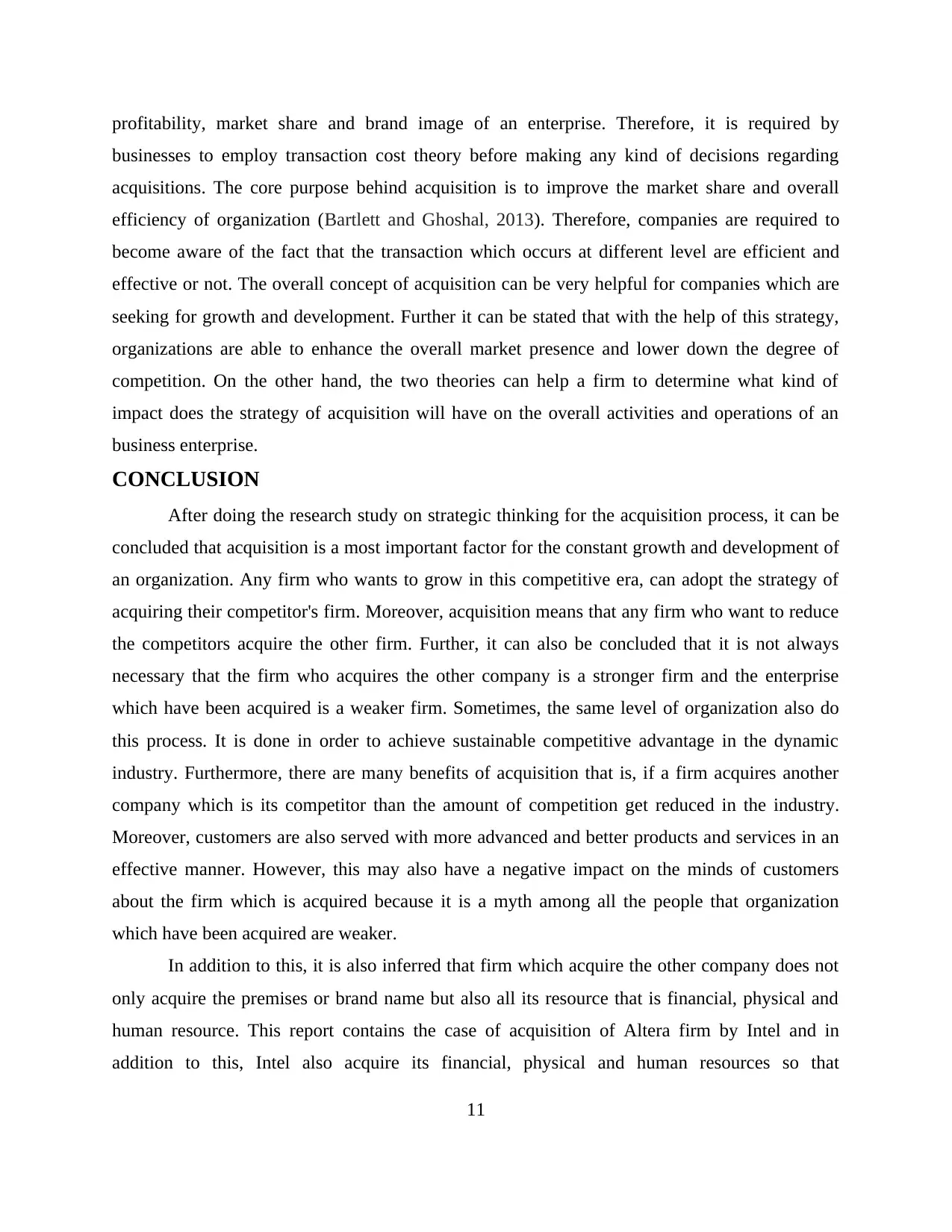
profitability, market share and brand image of an enterprise. Therefore, it is required by
businesses to employ transaction cost theory before making any kind of decisions regarding
acquisitions. The core purpose behind acquisition is to improve the market share and overall
efficiency of organization (Bartlett and Ghoshal, 2013). Therefore, companies are required to
become aware of the fact that the transaction which occurs at different level are efficient and
effective or not. The overall concept of acquisition can be very helpful for companies which are
seeking for growth and development. Further it can be stated that with the help of this strategy,
organizations are able to enhance the overall market presence and lower down the degree of
competition. On the other hand, the two theories can help a firm to determine what kind of
impact does the strategy of acquisition will have on the overall activities and operations of an
business enterprise.
CONCLUSION
After doing the research study on strategic thinking for the acquisition process, it can be
concluded that acquisition is a most important factor for the constant growth and development of
an organization. Any firm who wants to grow in this competitive era, can adopt the strategy of
acquiring their competitor's firm. Moreover, acquisition means that any firm who want to reduce
the competitors acquire the other firm. Further, it can also be concluded that it is not always
necessary that the firm who acquires the other company is a stronger firm and the enterprise
which have been acquired is a weaker firm. Sometimes, the same level of organization also do
this process. It is done in order to achieve sustainable competitive advantage in the dynamic
industry. Furthermore, there are many benefits of acquisition that is, if a firm acquires another
company which is its competitor than the amount of competition get reduced in the industry.
Moreover, customers are also served with more advanced and better products and services in an
effective manner. However, this may also have a negative impact on the minds of customers
about the firm which is acquired because it is a myth among all the people that organization
which have been acquired are weaker.
In addition to this, it is also inferred that firm which acquire the other company does not
only acquire the premises or brand name but also all its resource that is financial, physical and
human resource. This report contains the case of acquisition of Altera firm by Intel and in
addition to this, Intel also acquire its financial, physical and human resources so that
11
businesses to employ transaction cost theory before making any kind of decisions regarding
acquisitions. The core purpose behind acquisition is to improve the market share and overall
efficiency of organization (Bartlett and Ghoshal, 2013). Therefore, companies are required to
become aware of the fact that the transaction which occurs at different level are efficient and
effective or not. The overall concept of acquisition can be very helpful for companies which are
seeking for growth and development. Further it can be stated that with the help of this strategy,
organizations are able to enhance the overall market presence and lower down the degree of
competition. On the other hand, the two theories can help a firm to determine what kind of
impact does the strategy of acquisition will have on the overall activities and operations of an
business enterprise.
CONCLUSION
After doing the research study on strategic thinking for the acquisition process, it can be
concluded that acquisition is a most important factor for the constant growth and development of
an organization. Any firm who wants to grow in this competitive era, can adopt the strategy of
acquiring their competitor's firm. Moreover, acquisition means that any firm who want to reduce
the competitors acquire the other firm. Further, it can also be concluded that it is not always
necessary that the firm who acquires the other company is a stronger firm and the enterprise
which have been acquired is a weaker firm. Sometimes, the same level of organization also do
this process. It is done in order to achieve sustainable competitive advantage in the dynamic
industry. Furthermore, there are many benefits of acquisition that is, if a firm acquires another
company which is its competitor than the amount of competition get reduced in the industry.
Moreover, customers are also served with more advanced and better products and services in an
effective manner. However, this may also have a negative impact on the minds of customers
about the firm which is acquired because it is a myth among all the people that organization
which have been acquired are weaker.
In addition to this, it is also inferred that firm which acquire the other company does not
only acquire the premises or brand name but also all its resource that is financial, physical and
human resource. This report contains the case of acquisition of Altera firm by Intel and in
addition to this, Intel also acquire its financial, physical and human resources so that
11
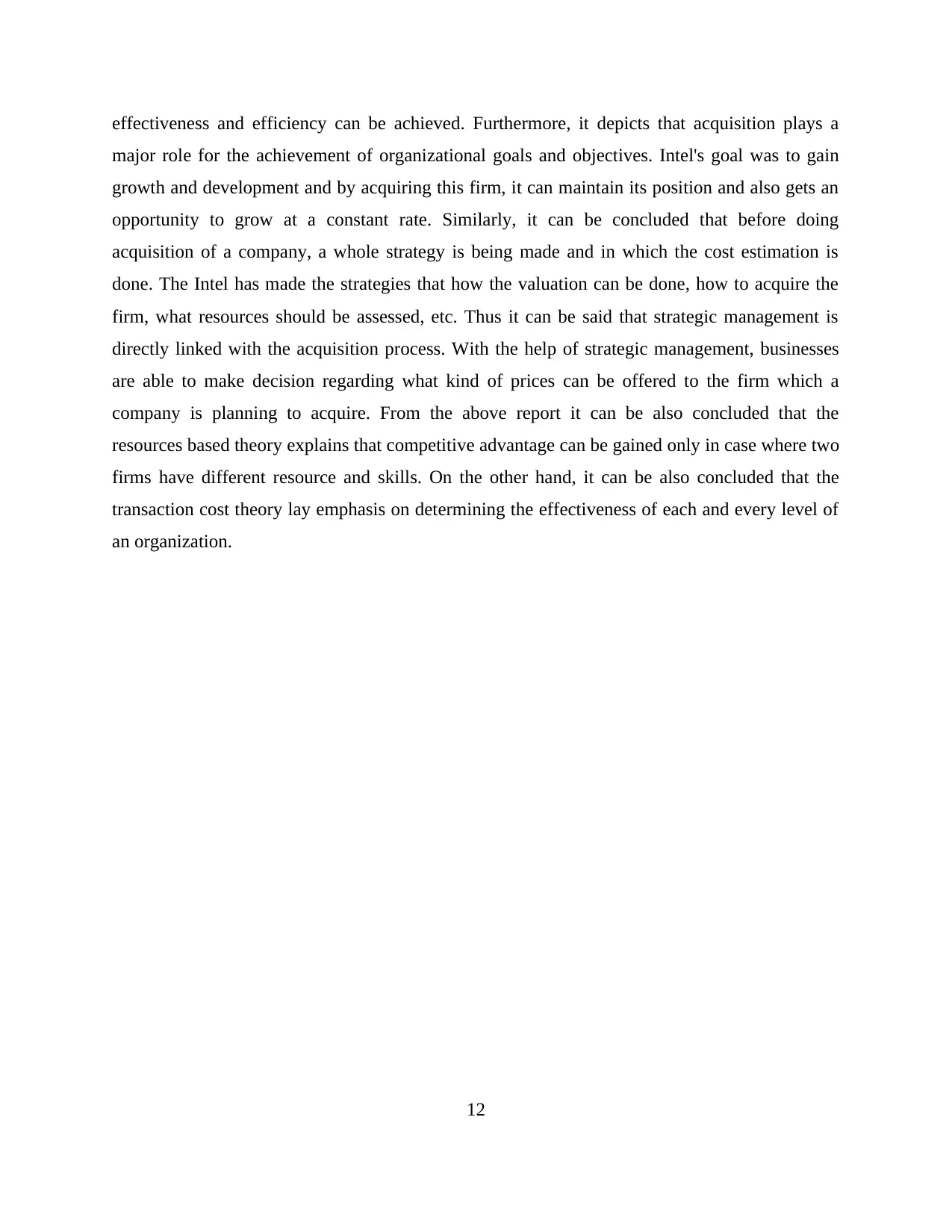
effectiveness and efficiency can be achieved. Furthermore, it depicts that acquisition plays a
major role for the achievement of organizational goals and objectives. Intel's goal was to gain
growth and development and by acquiring this firm, it can maintain its position and also gets an
opportunity to grow at a constant rate. Similarly, it can be concluded that before doing
acquisition of a company, a whole strategy is being made and in which the cost estimation is
done. The Intel has made the strategies that how the valuation can be done, how to acquire the
firm, what resources should be assessed, etc. Thus it can be said that strategic management is
directly linked with the acquisition process. With the help of strategic management, businesses
are able to make decision regarding what kind of prices can be offered to the firm which a
company is planning to acquire. From the above report it can be also concluded that the
resources based theory explains that competitive advantage can be gained only in case where two
firms have different resource and skills. On the other hand, it can be also concluded that the
transaction cost theory lay emphasis on determining the effectiveness of each and every level of
an organization.
12
major role for the achievement of organizational goals and objectives. Intel's goal was to gain
growth and development and by acquiring this firm, it can maintain its position and also gets an
opportunity to grow at a constant rate. Similarly, it can be concluded that before doing
acquisition of a company, a whole strategy is being made and in which the cost estimation is
done. The Intel has made the strategies that how the valuation can be done, how to acquire the
firm, what resources should be assessed, etc. Thus it can be said that strategic management is
directly linked with the acquisition process. With the help of strategic management, businesses
are able to make decision regarding what kind of prices can be offered to the firm which a
company is planning to acquire. From the above report it can be also concluded that the
resources based theory explains that competitive advantage can be gained only in case where two
firms have different resource and skills. On the other hand, it can be also concluded that the
transaction cost theory lay emphasis on determining the effectiveness of each and every level of
an organization.
12
⊘ This is a preview!⊘
Do you want full access?
Subscribe today to unlock all pages.

Trusted by 1+ million students worldwide
1 out of 14
Related Documents
Your All-in-One AI-Powered Toolkit for Academic Success.
+13062052269
info@desklib.com
Available 24*7 on WhatsApp / Email
![[object Object]](/_next/static/media/star-bottom.7253800d.svg)
Unlock your academic potential
Copyright © 2020–2025 A2Z Services. All Rights Reserved. Developed and managed by ZUCOL.





